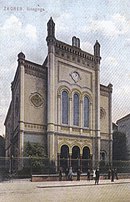
Back Portal:Judetum ALS بوابة:اليهودية Arabic Википедия:Портал:Йәһүдилек Bashkir Portal:Judndum BAR Portál:Hebraistika Czech Portal:Judentum German Portal:Cıhudiye DIQ Portalo:Judismo Esperanto Portal:Judaísmo Spanish Portail:Judaïsme French
The Judaism PortalJudaism (Hebrew: יַהֲדוּת, romanized: Yahăḏūṯ) is an Abrahamic monotheistic ethnic religion that comprises the collective spiritual, cultural, and legal traditions of the Jewish people. Judaism evolved from Yahwism, an ancient Semitic religion of the late Bronze Age to early Iron Age, likely around the 6th/5th century BCE. Along with Samaritanism, to which it is closely related, Judaism is one of the two oldest Abrahamic religions. Religious Jews regard Judaism as their means of observing the Mosaic covenant, which was established between God and the Israelites, their ancestors. Jewish religious doctrine encompasses a wide body of texts, practices, theological positions, and forms of organization. Among Judaism's core texts is the Torah, the first five books of the Hebrew Bible, a collection of ancient Hebrew scriptures. The Tanakh, known in English as the Hebrew Bible, is also referred to as the "Old Testament" in Christianity. In addition to the original written scripture, the supplemental Oral Torah is represented by later texts, such as the Midrash and the Talmud. The Hebrew-language word torah can mean "teaching", "law", or "instruction", although "Torah" can also be used as a general term that refers to any Jewish text that expands or elaborates on the original Five Books of Moses. Representing the core of the Jewish spiritual and religious tradition, the Torah is a term and a set of teachings that are explicitly self-positioned as encompassing at least seventy, and potentially infinite, facets and interpretations. Judaism's texts, traditions, and values strongly influenced later Abrahamic religions, including Christianity and Islam. Hebraism, like Hellenism, played a seminal role in the formation of Western civilization through its impact as a core background element of Early Christianity. (Full article...) Selected ArticleTemple Israel is a Reform Jewish congregation in Memphis, Tennessee. It is the only Reform synagogue in Memphis, the oldest and largest Jewish congregation in Tennessee, and one of the largest Reform congregations in the United States. It was founded in 1853 by mostly German Jews as Congregation B'nai Israel. Led initially by cantors, in 1858 it hired its first rabbi, Jacob Peres, and leased its first building, which it renovated and eventually purchased. The synagogue was one of the founding members of the Union for Reform Judaism. It experienced difficulty during the Great Depression—membership dropped, the congregational school was closed, and staff had their salaries reduced—but conditions had improved by the late 1930s. In 1943 the synagogue changed its name to Temple Israel, and by the late 1940s membership had almost doubled from its low point in the 1930s. Rabbi Jimmy Wax became known for his activism during the Civil Rights era. In 1976 the congregation constructed its current building, closer to where most members lived. Wax retired in 1978, and was succeeded by Harry Danziger, who brought traditional practices back to the congregation. He retired in 2000, and was succeeded by Micah Greenstein. As of 2010[update], Temple Israel has almost 1,600 member families. Greenstein is the senior rabbi, and the cantor is John Kaplan. (Read more...) Did You Know?Did you know...
Related Categories
Featured Articles
Related PortalsHistory ArticleThe Zagreb Synagogue was the main place of worship for the Jewish community of Zagreb in modern-day Croatia, from its construction in 1867 in the Kingdom of Croatia-Slavonia within the Austrian Empire, until its demolition by the fascist authorities in 1941 in the Axis-aligned Independent State of Croatia. The Moorish Revival synagogue was located on modern-day Praška Street and has been the only purpose-built Jewish house of worship in the history of the city. It was one of the city's most prominent public buildings, as well as one of the most esteemed examples of synagogue architecture in the region. Since the 1980s, plans have been made to rebuild the synagogue in its original location, but due to various political circumstances, very limited progress has been made. The current major disagreements which inhibit the construction of a new synagogue concern the involvement of Jewish organizations in the reconstruction and the design and character of the new building. (Read more...) Picture of the WeekIn the News
Featured Quote
WikiProjectsThings You Can Do
Weekly Torah Portion
TopicsAssociated WikimediaThe following Wikimedia Foundation sister projects provide more on this subject:
Discover Wikipedia using portals | |||||||||
© MMXXIII Rich X Search. We shall prevail. All rights reserved. Rich X Search



























